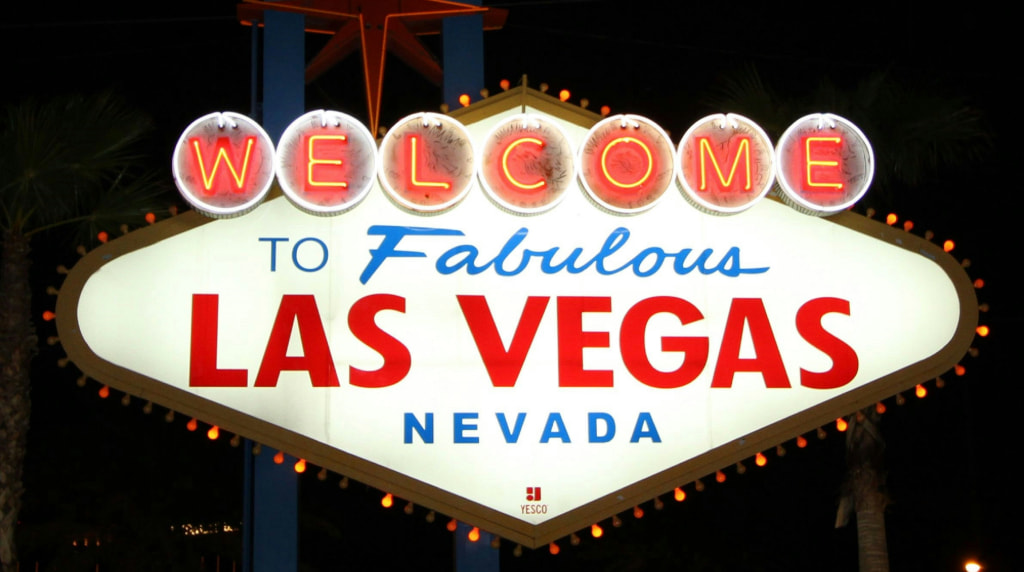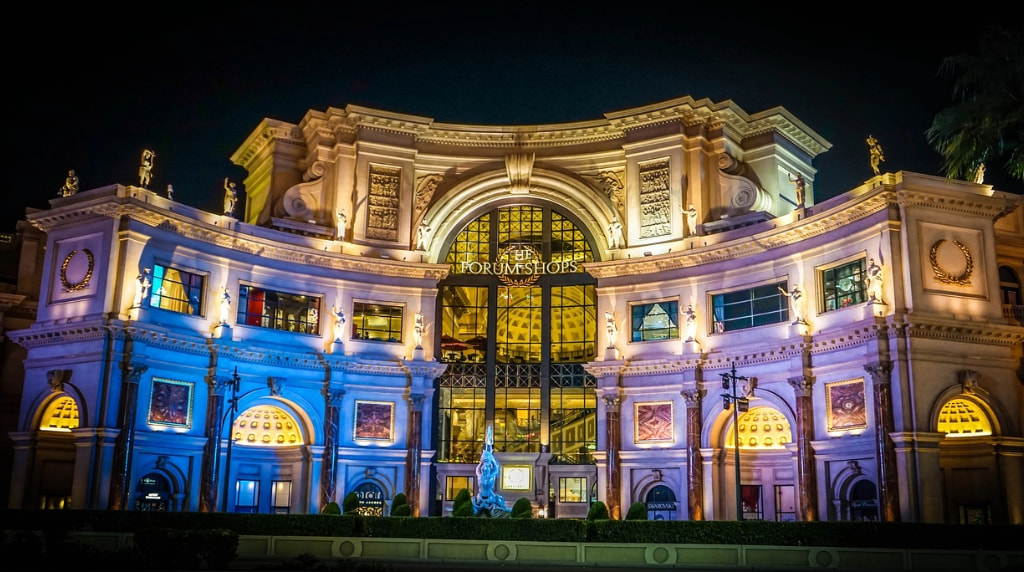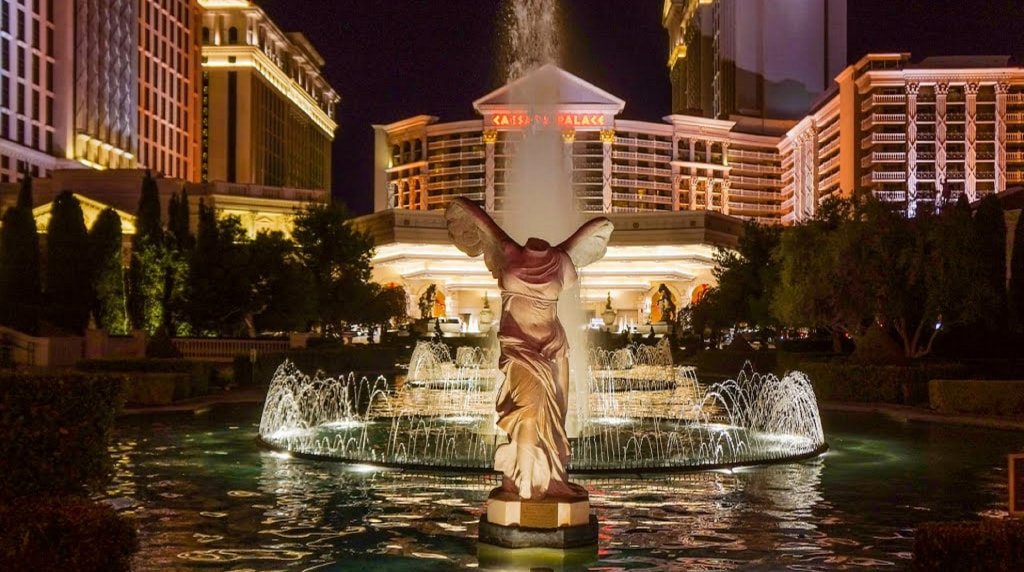Caesars Palace: How a Roman Fantasy Shaped Modern Las Vegas
Caesars has defined Las Vegas luxury for nearly six decades. Known for its Roman-inspired architecture and lavish amenities, this temple to excess is seared into Las Vegas history for its over-the-top amenities and its transformative ideas. Ideas that would shape the Strip and leave a lasting impact on the casino industry nationwide.

Throughout Caesars’ long history, this sign has welcomed visitors. © Manish Tulaskar, Unsplash
Caesars Palace History: The Early Years
It’s unlikely many people took too much notice of Jay Sarno when he first started visiting Las Vegas in the late Fifties and early Sixties. And even if you were one of the well-connected wise guys in town, of which there were many back then, the only thing you would take care to remember about the man was that he was a good friend of Alan Dorfman and Jimmy Hoffa, two extremely mobbed-up Teamster Union officials.
But truly, you can’t tell the history of Caesars without telling the history of the mob and the teamsters. Sarno had built some hotels in Atlanta, Dallas, and Palo Alto with teamster loans, and he had decided by 1963 that he was the man to build the next better mousetrap in Las Vegas. And mousetraps don’t come cheap, especially in the desert.
Opening Doors
Sarno and his partner Stan Mallin would spend about $24 million to build out their Roman Bachnalian fantasy, kicking open the doors in 1966 with a blowout three-day party that is still talked about today. That comes to about 250 million in 2024 money, which perhaps doesn’t seem that striking in today’s multi-billion dollar casino/resort world but was undoubtedly a record for that time.
It’s important to remember they were only leasing the land Caesars sat on for the first five years, with an option to buy, and that while Caesars would eventually undergo over one billion in renovations, it opened with only 680 rooms in 1966. Today, it has over 3900.
With over $10 million loaned from just the Teamsters, it was entangled with the mob and mob politics from the very start. Unfortunately, this put some staffing decisions, such as the casino manager and members of the count team, at the mercy of the lenders. Jerome Zarowitz, who oversaw casino operations, would spend the first 3 years skimming money to send back to the New York Genovese and Boston Patriarca Crime families.
Hoffa’s and Sarno’s Influence
Things were also complicated by Hoffa being sent to Lewisburg Prison in 1967. Acting Teamsters president Frank Fitzsimmons, no doubt feeling the extreme heat, began to distance the Teamsters from mob influence and its Las Vegas King Maker status, albeit slowly.
While not immediately apparent as Caesars was doing gangbusters business, if you’ll pardon the term, the beginning of the end of Hoffa’s control of the Teamsters pension fund, along with wiretaps on the North East mob families showing the extent of the skim would so spell the end for Jay Sarno and his Gatsbyesque dreams in a few short years.
Show and Entertainment for the Masses
But in the meantime, Sarno did what he was best at. He put on a show, and he was everywhere, from the front pages of the papers to the Johnny Carson show. He brought Sinatra over from the Sands, a feat most thought impossible.
Evel Knievel outfoxed him with fake calls from supposed reporters from Sports Illustrated and ABC, which publicity fiend Sarno couldn’t resist and agreed to let him attempt to jump the Caesars Palace fountains.
While disastrous at the time, the resulting publicity from the horrific motorcycle crash would only further sear both Caesars and Kneival into the popular imagination, which was Sarno’s true gift. His protege Steve Wynn, who would take over the Golden Nugget downtown in 1971, just as Sarno’s time began to run out in Sin City, would say Sarno’s true genius was in eliciting an emotional response from customers.
I want people to be transported by the hotel,” he says. “I’m thinking, What is it that would make people be delighted and amazed?– Steve Wynn, CEO, WYNN Las Vegas, Interview with Vanity Fair
Sarno understood that customers wanted more than a giant box filled with slot and table games adjacent to a place to sleep and a quick place to grab a bite to eat when they were hungry. They wanted an experience, an adventure, a slap to their senses, and that’s what he provided.
While his relatively short three years at the helm of Caesar would be nothing compared to Wynn’s decades in the public spotlight, what Sarno did in that short time would leave Caesar’s name, its legacy, and the dream of what it aspired to be still living in people’s minds 50+ years later.
Not the End, But the End of the Beginning
Jay Sarno’s loss of Caesars was written in the cards way back in 1958, when he first borrowed money from the Central State Pension Fund to build the Atlanta Cabana Motor Court. The government’s enmity toward the mob’s influence in Las Vegas, coupled with the wiretap evidence of the skim at Caesars organized by Zarowitz flowing to the crime families back east, meant that Sarno’s days at the helm of Caesars were always going to be short.
Sensing that the heat was on, he divested some of his money into the Circus Circus Project, which would open in late 1968. Circus Circus is a story in its own right. A family-themed attraction that nonetheless featured topless shoe shine girls, baby elephants in wire harnesses that would appear to fly, and also occasionally stop by the craps table to throw the dice with their trunk, and monkeys trained to pay slot jackpots.
Federal and State investigations continued into Jay Sarno and Caesars. When it became apparent that his ability to keep his license at Caesars Las Vegas was in jeopardy, he unloaded the company for $60 million to the Perlman Brothers and their Lum restaurant chain. Utterly shocking to no one, Lum and the Perlmans would be accused a decade later of being mobbed up, including a secret loan from none other than Myer Lansky.
Reaching New Heights
All that aside, though, it was Cliff Perlman and, to a lesser extent, his brother Stuart who would spend the next 13 years growing Caesars Las Vegas into a hugely profitable business.
They would also grow the Caesars World Company business both domestically and internationally, even opening offices to bring in international players in far-flung destinations like Mexico City and Hong Kong.
When Perlman bought the business, there were slightly under 600 rooms and almost $5 million a year in revenue. When he left in 1982, Caesars had grown to more than 1700 rooms and over $80 million in revenue. He would host huge concerts, boxing matches so large that they had to be held in tents in the parking lot, and of course, it was the place to see or be seen for everyone from Hollywood, from the aging rat packers to the avant-garde of the new cinema.
Massive Expansion
Having opened hundreds of restaurants across North America, the Perlman brothers clearly understood the power of franchising such a powerful brand name, so under their watch, Caesars opened new locations.
That included a wildly successful Caesars Lake Tahoe that catered to the Northern California market, and what they believed might be an even bigger opportunity than the original Caesars, a new property in Atlantic City with millions of people within a half days driving distance.
Much like Jay Sarno before him, this would prove to be Cliff Perlmans undoing. Perlman had plenty of warnings from the Nevada Gaming Control Board before everything went so spectacularly wrong with the New Jersey Division of Gaming Enforcement. But it turned out that New Jersey’s casino watchdog had actual teeth.
Ties with the Mafia
His prior business dealing with organized crime figures, notably Sam Cohen and Alvin Malnick, were well documented and irrefutable. Not only would this mean the end of his hopes for licensure in New Jersey, but the heat from subsequent Federal Investigations, especially the SEC.
The latter felt investors weren’t given adequate facts about possible exposure to the Genovese Crime family having back door ties to the casino, would eventually force the Perlmans from the entire business.
Though the Nevda Gaming Commission would once again license the Perlmans in 1983 to buy the Dunes, just three short years after they were forced out of New Jersey, many would call it a home-court advantage. That never stopped the Perlmans from pointing to the decision as a vindication of their innocence.
Pencil Pushers Prevail
Caesars Palace’s history takes a decided turn in 1983 when Henry Gluck was named CEO. Unlike Sarno, Gluck is not a casino visionary with the capacity or even the inclination to wow people. And unlike Perlman, he has no flair for intuiting what the customer wants or how to sell the promise or adventure of a Caesars’ stay.
But what he does possess is exactly what the ever-expanding Caesars needs: a great head for squeezing every last penny of revenue out of a quickly growing and expanding business.
Gluck doesn’t even have a casino background; his primary background was sitting on boards as diverse as Sheraton Hotel and Gibraltar Savings and Loan. But he would steward the Caesars properties for over a decade, making them a lean, mean revenue machine. He would also, at his wife’s behest, kick off the luxury shopping and gourmet trend that is still so markedly prevalent in Las Vegas today.
His wife reputedly found Las Vegas boring, with no shopping and no world-class dining, and urged him to open the world-famous Forum shops at Caesars to placate all the wives and girlfriends who had nothing to do but lay by the pool all day.
He would also oversee the opening of the Caesars in Ontario and prove the Perlmans prescient in their Atlantic City bid. While the Caesars Boardwalk Regency opened in 1979, it won’t be until Gluck’s relentless wrangling of costs and overhead that the asset really began to shine in the mid-80s.
Due to his success keeping costs in line, Gluck also had to face off several buyout attempts throughout the overly leveraged 1980s by larger firms hoping to capitalize on Caesar’s ability to spin off cold, hard cash, including one by Donald Trump. But Gluck was successful each time.
The Buyout Years
1995 ITT bought Caesars World for 1.7 billion; in 1998, they were sold again to Starwood and then again in 2000 to Park Place. Park Place, believing that the Caesars name still retained some panache, renamed Park Place to Caesars Entertainment, but by 2004, this new company was sold yet again to Harrah’s for a whopping $10 billion. Then, in 2006, Apollo Capitol and Blackstone bought the whole lot. These two large investment firms had absolutely no experience running casinos. They paid $17.1 billion in cash, which was all debt-financed. When the deal closed in 2008, Harrah’s was taken private, owing 25 billion in debt.
In 2010, the company once again decided to capitalize on the name recognition that Sarno and Perlman had worked so tirelessly to create in the 1960s and 1970s. It renamed the company Caesars Entertainment Corporation and took it public again in 2012.
If one assumed it was only the mob that knew how to bust out a joint, meaning strip a business of its assets by selling them off, putting them in debt, and then closing them down, they would have marveled at the inventiveness of Wall Street.
In any case, the company transferred most of its debts to a company called Caesars Acquisition Group and over 150 other subsidiaries, who then filed Chapter 11 bankruptcy, while the parent company, Caesars Entertainment, did not, costing lenders and investors billions.
Moving Online
In 2013, Caesars Palace Online Casino opened its virtual doors with three initial online websites in New Jersey, one of the first states to allow online gambling. WSOP.com, HarrahsCasino.com, and CaesarsCasino.com are all instant hits with the Garden State Public.
In 2019, the company merged with gaming giant Eldorado Resorts in a deal worth more than 17 billion. The company still trades under the ticker CZR. Between the two combined companies, they have 55 casinos in 16 states and 8 Las Vegas Strip properties, including the still iconic and competitive Caesars Las Vegas. They have online sportsbooks in over 21 states and offer online gambling in the U.S. in an additional 4 states so far.
Six Decades of Excellence
The history of Caesars Palace is inseparable from the visionaries who built it. Jay Sarno’s crazy dream of creating an over-the-top Roman-themed paradise forever changed Las Vegas. He took the Vegas experience from functional to fantastical and set a precedent for everyone else to follow. His focus on eliciting emotion from guests and imparting a sense of wonder and escapism laid the groundwork for what Las Vegas would become.
Cliff Perlman took that dream and expanded it beyond even Sarno’s imagination. His business acumen and nose for publicity turned Caesars Palace into a global brand, one that reached new heights of luxury and exclusivity. The Perlman brothers understood the power of the Caesars name and used it to define a new era of gaming and entertainment.
Both Sarno and Perlman fell to the same fortunes they tapped to make Caesars great, untold millions in mob money. But, they changed Las Vegas from a dusty regional gambling hub into an international destination for luxury, entertainment, and innovation.
Their work lives on in every corner of the Strip and in every casino town that has adapted their ideas. Even 60 years later, their fingerprints are evident in the grandeur and glory that define modern Las Vegas.







